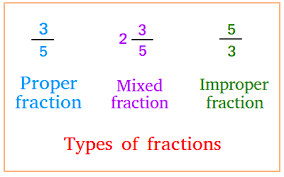Fractions are foundational concepts in mathematics, representing parts of a whole or ratios of quantities. Understanding how to identify, understand and work out fractions is essential for solving mathematical problems and interpreting real-life scenarios involving proportions and comparisons. As such, this comprehensive blog explores the intricacies of fractions, focusing on identifying proper and improper fractions, converting between improper fractions and mixed numbers, identifying equivalent fractions, and arranging fractions in ascending and descending order. Thus, by the end of this exploration, you’ll be equipped with the knowledge and skills to confidently work with fractions and tackle a variety of mathematical challenges.
Before we go deeper into exploring integers and number lines, I would like to remind you as a learner that LearnersCamp provides additional insights into these disparities. Additionally, LearnersCamp has grown to become a valuable platform for learners seeking to deepen their understanding of mathematical concepts. Moreover, it has a user-friendly interface and a vast array of educational materials, including articles, tutorials, and interactive quizzes; LearnersCamp offers comprehensive guidance on such topics. Hence, by visiting LearnersCamp, learners can access clear explanations, practical examples, and engaging exercises to solidify their grasp of these fundamental mathematical principles.
Understanding how to identify, understand and work out fractions:
Firstly, before we delve into specific operations, let’s distinguish between two main types of fractions: proper and improper fractions.
- Proper Fractions:
Proper fractions are fractions where the numerator (the top number) is less than the denominator (the bottom number). They represent values less than one whole. Example: 3/4, 2/5, 1/3 - Improper Fractions:
Improper fractions are fractions where the numerator is equal to or greater than the denominator. They represent values equal to or greater than one whole. Example: 5/3, 7/2, 9/4
Practical Illustration on how to identify, understand and work out fractions:
Consider a pizza sliced into equal parts. Each slice represents a fraction of the whole pizza. If you have less than one whole slice, it’s a proper fraction. If you have one whole slice or more, it’s an improper fraction.
- Conversion Between Improper Fractions and Mixed Numbers:
Converting between improper fractions and mixed numbers allows us to represent fractions in different forms. Let’s explore how to perform these conversions:
- Converting Improper Fractions to Mixed Numbers:
To convert an improper fraction to a mixed number, divide the numerator by the denominator. The quotient becomes the whole number part, and the remainder becomes the numerator of the fraction part. Example:
7/4 can be converted to a mixed number as follows:
7/4 = 1 3/4 - Converting Mixed Numbers to Improper Fractions:
To convert a mixed number to an improper fraction, multiply the whole number by the denominator, add the numerator, and place the sum over the denominator. Example:
2 2/5 can be converted to an improper fraction as follows:
2 2/5 = {((2 x 5) + 2) /(5)} = {10 + 2} /{5} = 12/5
Practical Illustration:
Imagine you have 7/4 of a pizza. Converting it to a mixed number, you have 1 whole pizza and 3/4 of another pizza.
- Identifying Equivalent Fractions:
Equivalent fractions represent the same value but are expressed in different forms. They have the same proportion or ratio.
To identify equivalent fractions, multiply or divide both the numerator and denominator by the same non-zero number.
- Example:
1/2, 2/4, and 3/6 are equivalent fractions because they represent the same proportion of a whole.
- Practical Illustration:
Imagine you have a cake divided into halves. Cutting each half into two equal parts gives you four quarters. Each quarter is equivalent to half of the cake.
- Arranging Fractions in Ascending and Descending Order:
Arranging fractions in ascending (from smallest to largest) and descending (from largest to smallest) order helps in comparing and organizing numerical values.
Notably, to arrange fractions in ascending or descending order, compare their values using common denominators or by converting them to equivalent fractions with the same denominator.
- Practical Illustration:
Consider the fractions 3/5, 4/7, and 2/3. By finding a common denominator (e.g., 105), you can compare their values and arrange them accordingly.
Conclusion:
In conclusion, fractions are versatile mathematical tools used to represent parts of a whole or ratios of quantities. Thus, by understanding how to identify, understand and work out fractions, converting between improper fractions and mixed numbers, identifying equivalent fractions, and arranging fractions in ascending and descending order, you’ll be equipped to confidently work with fractions and solve a variety of mathematical problems. Hence, through practical illustrations and examples, we’ve explored the intricacies of fractions, reinforcing key concepts and techniques. So, whether you’re dividing ingredients for a recipe, calculating proportions in a business setting, or solving mathematical problems, remember to leverage the power of fractions to achieve accurate and meaningful results.









